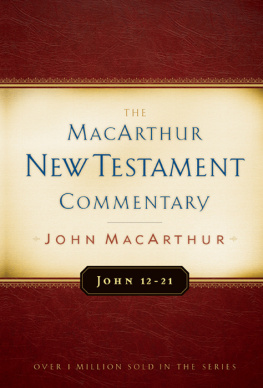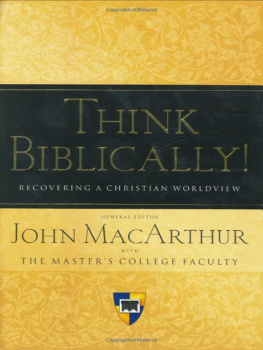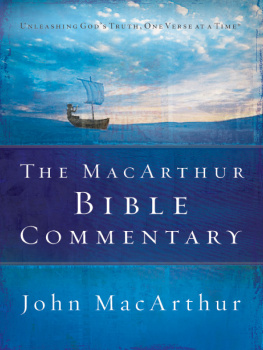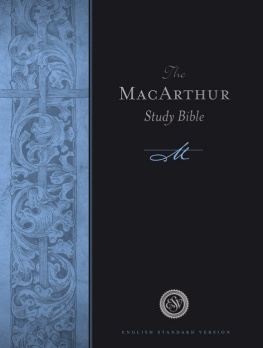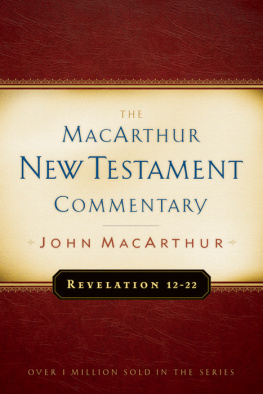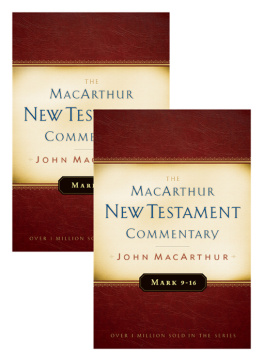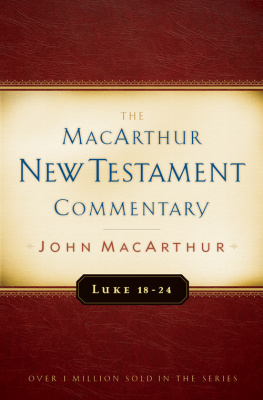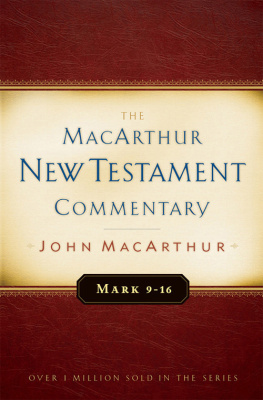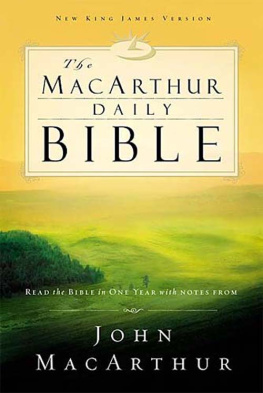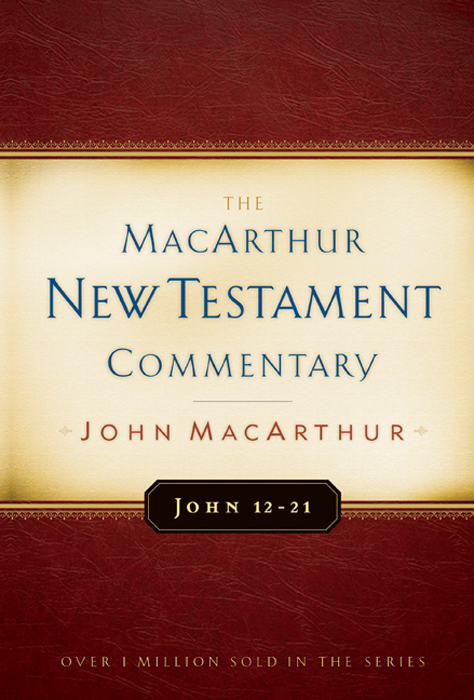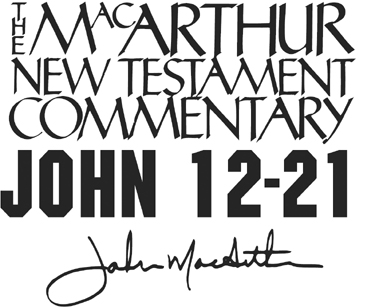
M OODY P UBLISHERS
CHICAGO
2008 by
J OHN M AC A RTHUR
All rights reserved. No part of this book may be reproduced in any form without permission in writing from the publisher, except in the case of brief quotations embodied in critical articles or reviews.
All Scripture quotations, unless otherwise indicated, are taken from the New American Standard Bible, Copyright The Lockman Foundation, 1960, 1962, 1963, 1968, 1971, 1972, 1973, 1975, 1977, 1995. Used by permission.
Scripture quotations marked ESV are taken from The Holy Bible, English Standard Version. Copyright 2000, 2001 by Crossway Bibles, a division of Good News Publishers. Used by permission. All rights reserved.
Scripture quotations marked NKJV are taken from the New King James Version. Copyright 1982 by Thomas Nelson, Inc. Used by permission. All rights reserved.
Scripture quotations marked KJV are taken from the King James Version.
Library of Congress Cataloging-in-Publication Data
MacArthur, John, 1939
John 12-21 / John MacArthur.
p. cm.- (The MacArthur New Testament commentary)
Includes bibliographical references and index.
ISBN-13:978-0-8024-0824-2
ISBN-10:0-8024-0824-9
1.Bible.N.T.John XII-XXICommentaries. I.Title.
BS2615.53.M34 2008
226.5077dc22
2007047180
We hope you enjoy this book from Moody Publishers. Our goal is to provide high-quality, thought-provoking books and products that connect truth to your real needs and challenges. For more information on other books and products written and produced from a biblical perspective, go to www.moodypublishers.com or write to:
Moody Publishers
820 N. LaSalle Boulevard
Chicago, IL 60610
1 3 5 7 9 10 8 6 4 2
Printed in the United States of America
To David and Mary Anne Wismer,
who share my love for the Truth, written and incarnate,
and whose abundant kindness and lasting friendship
have graced my life with encouragement and joy.
Contents
CHAPTER
Preface
The message of Johns gospel is simple. The apostle writes with straightforward clarity and in words that make the truth accessible to every reader. That fact is critical, because this is the saving gospel, written for unbelievers. John said so:
Many other signs Jesus also performed in the presence of the disciples, which are not written in this book; but these have been written so that you may believe that Jesus is the Christ, the Son of God; and that believing you may have life in His name. (John 20:3031)
I have tried in this commentary to keep verbiage out and say only what is directly helpful to the understanding of the text. There is little digression and no attempt to give embellishing content. This is a departure from the style of my other commentaries, where I often introduce an abundance of related theological and illustrative material. That is not to say there are not glorious themes throughout John that can and should be developed in the process of exposition, and by comparing Scripture with Scripture. But for the most part I have left that task to others this time, in favor of flow and concise adherence to the apostle Johns own stated intent. At times I felt I should write more; sometimes less. But my deliberate goal throughout has been to serve the inspired message by restraint, minimizing interruptions, and letting the Word speak without adding anything more than essential explanations, without drifting from the text itself into parallel passagesthus keeping the simplicity and clarity of the Spirits inspired truth uncluttered. I hope I have done that.
In this profound yet plain account of the coming of the Son of God to redeem sinners is the most needed message anyone will ever hear or understand. With just a little clarification and background, it proclaims to the mind of the willing and humble sinner the truth that transforms eternally.
J OHN M AC A RTHUR
February 2008
The Climax of Love and Hate
(John 12:111)
Jesus, therefore, six days before the Passover, came to Bethany where Lazarus was, whom Jesus had raised from the dead. So they made Him a supper there, and Martha was serving; but Lazarus was one of those reclining at the table with Him. Mary then took a pound of very costly perfume of pure nard, and anointed the feet of Jesus and wiped His feet with her hair; and the house was filled with the fragrance of the perfume. But Judas Iscariot, one of His disciples, who was intending to betray Him, said, Why was this perfume not sold for three hundred denarii and given to poor people? Now he said this, not because he was concerned about the poor, but because he was a thief, and as he had the money box, he used to pilfer what was put into it. Therefore Jesus said, Let her alone, so that she may keep it for the day of My burial. For you always have the poor with you, but you do not always have Me. The large crowd of the Jews then learned that He was there; and they came, not for Jesus sake only, but that they might also see Lazarus, whom He raised from the dead. But the chief priests planned to put Lazarus to death also; because on account of him many of the Jews were going away and were believing in Jesus. (12:111)
The incarnation of the Lord Jesus Christ marks the zenith of history. His life not only divides the calendar (B.C. means before Christ; A.D. [anno Domini] means in the year of the Lord), but also human destiny. As Jesus Himself warned those who rejected Him, Unless you believe that I am He, you will die in your sins (John 8:24), and on another occasion, Do you suppose that I came to grant peace on earth? I tell you, no, but rather division (Luke 12:51; cf. Luke 2:34). Like no one else, Jesus Christ evokes the antithetical extremes of love and hate, devotion and rejection, worship and blasphemy, and faith and unbelief. How people respond to Him divides the sheep from the goats; the wheat from the tares; believers from unbelievers; the saved from the lost.
John wrote his gospel to present Jesus as the Son of God and the Messiah (20:31). In so doing, he also recorded how people reacted to Jesus messianic claims and miraculous signs. The apostle accordingly cites numerous examples of those who believed in Jesus (1:3551; 2:11; 4:2829, 4142, 53; 6:69; 9:3538; 10:42; 11:27, 45; 12:11; 16:27, 30; 17:8; 19:3839; 20:2829), and those who rejected Him (1:1011; 2:20; 3:32; 5:1618, 3847; 6:36, 4143, 64, 66; 7:1, 5, 20, 2627, 3052; 8:1359; 9:16, 29, 4041; 10:20, 2526; 11:4657; 12:3740).
In this passage, which relates the story of Marys anointing of Jesus, the themes of belief and unbelief are particularly clear. The worshipful act of Mary epitomizes faith and love; the cold, calculated, cynical response of Judas epitomizes unbelief and hatred. The section also records other reactions to Jesus, including the devoted service of Martha, the indifference of the crowd, and the hostility of the religious leaders.
The Lords raising of Lazarus had stirred up murderous opposition from the hostile Jewish leaders (11:4653). They decided that they had to kill both Jesus and Lazarus. Since His hour to die had not yet come (7:30; 8:20; 12:23; 13:1), Jesus left the vicinity of Jerusalem and stayed in the village of Ephraim (11:54), about a dozen miles to the north on the edge of the wilderness. From there He made a brief visit to Samaria and Galilee (Luke 17:1119:28) and then, six days before the Passover, came

